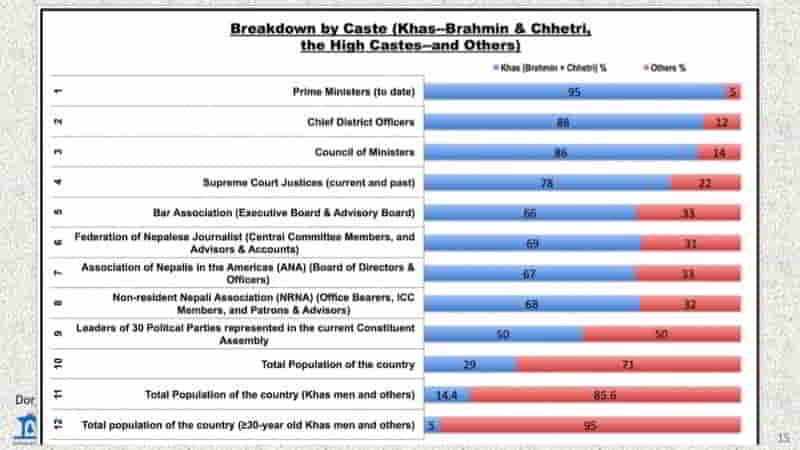MOVING ON to the next marginalized group…the Tharus in Terai continue to suffer as a consequence of past injustices.
The Tharus’ poverty, in the face of discrimination and violation of their rights, is so extreme that they suffered through life as indentured laborers in their own land, referred to as Kamaiya, some forced to sell their daughters into bondage, called Kamlaris.
Here’s a clip from a documentary also by my friend Subina about their plight and the practice of Kamlari.
[Only scenes from the first 8 minutes, edited down to about 4 minutes, were actually used in the presentation.]
More than a dacade has passed since both the practices of Kamiya and Kamlaris have been outlawed. But the suffering and marginalization of the Tharus continue.
[See Amnesty International’s Human Rights Violations of Indigenous Tharus after the August 2015 Police Killings in Kailali for more.]
WHAT ALL that has meant in the country is a disproportionately high representation of not just men, but hill so-called high caste Hindu men both in civil service and private sector, for instance.
High caste men of 30 or over — ones that constitute only 5% of the population — have held, and continue to hold, an overwhelming positions of power in the county.
That in spite of anti-discrimination laws being passed, first in 1963, and then in 1990. That in spite education being made universal in 1990. That in spite of the 1990 constitution being considerably more inclusive and progressive etc.
One of the rallying calls for ordinary Nepalese to join the recent ten-year civil war was the promise of a just society, based on the principles of equality, as summerized very well in the following clip from the documentary Born Polluted.
[What I included in the presentation starts at the 9 min mark as video below does but only parts of the clip until the 15:37 min. mark were used in the short 3-minute clip I showed.]
Following the civil war and the abolishment of the monarchy, there was considerable hope in all quarters for a more inclusive constitution to begin breaking down the inherent structural inequality in our caste-based social structure and highly patriarchal society.
Many hoped that the new constitution would pave the way for a considerably more egalitarian, socially equitable and inclusive society. As we all know, the 2008 Constituent Assembly failed in its mission and was dissolved in 2012.
Another round of elections were held in November 2013, and finally the constitution was promulgated last year, on September 20, which, however, disappointed many.

